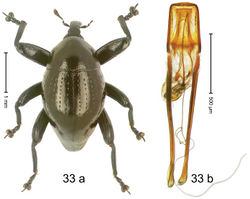Trigonopterus gonatoceros
| Notice: | This page is derived from the original publication listed below, whose author(s) should always be credited. Further contributors may edit and improve the content of this page and, consequently, need to be credited as well (see page history). Any assessment of factual correctness requires a careful review of the original article as well as of subsequent contributions.
If you are uncertain whether your planned contribution is correct or not, we suggest that you use the associated discussion page instead of editing the page directly. This page should be cited as follows (rationale):
Citation formats to copy and paste
BibTeX: @article{Riedel2013ZooKeys280, RIS/ Endnote: TY - JOUR Wikipedia/ Citizendium: <ref name="Riedel2013ZooKeys280">{{Citation See also the citation download page at the journal. |
Ordo: Coleoptera
Familia: Curculionidae
Genus: Trigonopterus
Name
Trigonopterus gonatoceros Riedel sp. n. – Wikispecies link – ZooBank link – Pensoft Profile
Diagnostic description
Holotype, male (Fig. 33a). Length 2.90 mm. Color black. Body subovate; almost without constriction between pronotum and elytron; in profile evenly convex. Rostrum dorsally relatively flat, with two indistinct submedian rows of punctures, dorsolaterally with pair of furrows continuing along eye; surface weakly microreticulate. Pronotum sparsely punctate with double-punctures each consisting of two minute approximate punctures. Elytra with striae distinct, dorsally punctures small, laterally large; intervals flat, with row of minute punctures, subglabrous. Femora edentate. Metafemur with simple dorsoposterior edge; subapically with stridulatory patch. Tibial base dentiform, when leg extended tibial tooth overlapping femoral apex dorsally. Thoracic and abdominal venter with dense erect setae. Aedeagus (Fig. 33b) apically subangulate, subglabrous; transfer apparatus flagelliform, 1.5 X longer than body; endophallus with two pairs of sclerites; ductus ejaculatorius without bulbus. Intraspecific variation. Length 2.75–2.88 mm. Female venter subglabrous.
Material examined
Holotype (MZB): ARC1776 (EMBL # HE616053), WEST NEW GUINEA, Jayawijaya Reg., Bokondini, S03°40.345', E138°42.386' to S03°40.255', E138°42.189', 1655–1700 m, 18-VII-2010. Paratypes (SMNK, ZSM): 81 exx, ARC1777 (EMBL # HE616054), ARC1778 (EMBL # HE616055), same data as holotype.
Distribution
Jayawijaya Reg. (Bokondini). Elevation: ca. 1655–1700 m.
Biology
Beaten from foliage of montane forests.
Etymology
This epithet is based on a combination of the Greek nouns gonatos (knee) and ceros (horn) in apposition and refers to the peculiar extensions of the tibial base.
Notes
Trigonopterus gonatoceros Riedel, sp. n. was coded as “Trigonopterus sp. 121” by Tänzler et al. (2012)[1].
Original Description
- Riedel, A; Sagata, K; Surbakti, S; Rene Tänzler, ; Michael Balke, ; 2013: One hundred and one new species of Trigonopterus weevils from New Guinea ZooKeys, 280: 1-150. doi
Other References
- ↑ Tänzler R, Sagata K, Surbakti S, Balke M, Riedel A (2012) DNA barcoding for community ecology - how to tackle a hyperdiverse, mostly undescribed Melanesian fauna. PLoS ONE 7 (1): e28832. doi: 10.1371/journal.pone.0028832
Images
|
